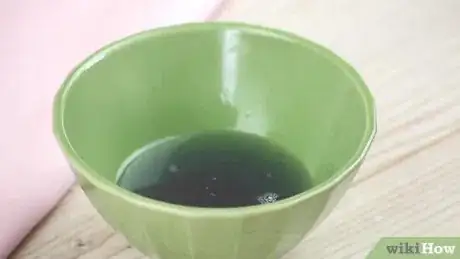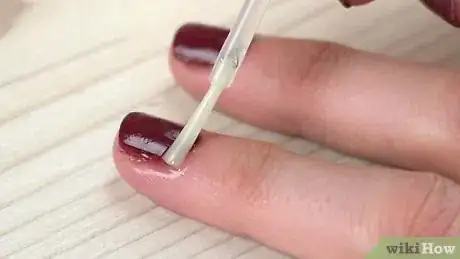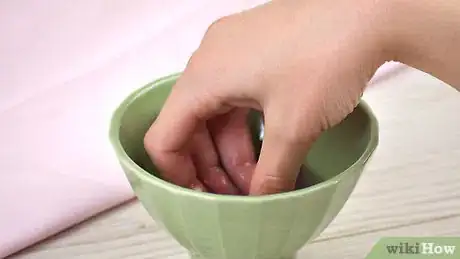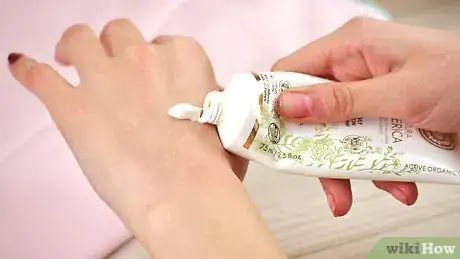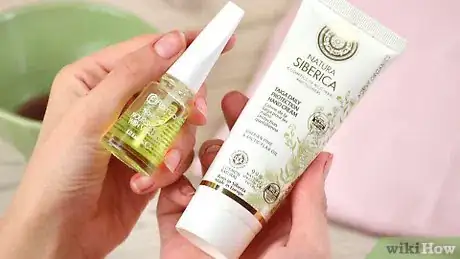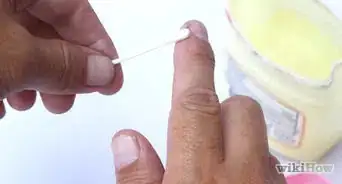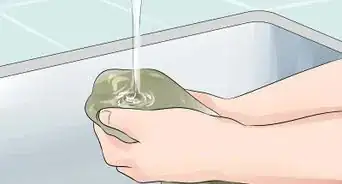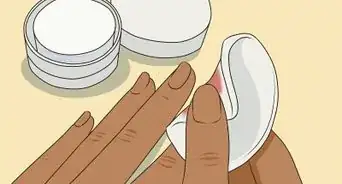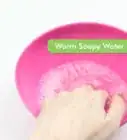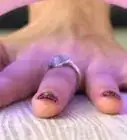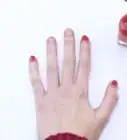wikiHow is a “wiki,” similar to Wikipedia, which means that many of our articles are co-written by multiple authors. To create this article, 22 people, some anonymous, worked to edit and improve it over time.
There are 11 references cited in this article, which can be found at the bottom of the page.
The wikiHow Video Team also followed the article's instructions and verified that they work.
This article has been viewed 2,786,052 times.
Learn more...
Shellac nail polish manicures are long-lasting, but sometimes you need a change. Instead of making a trip to the salon, you can remove your shellac nail polish right at home.
Steps
Soaking
-
1Fill a shallow bowl with acetone. Pure acetone will have the strongest effect, but acetone nail polish removers will also work as long as the concentration of acetone is around 60 percent or more.[1]
- Acetone-free nail polish removers or those that contain very little acetone will not be effective for removing shellac nail polish.[2]
- You can use pure acetone, which is available at most drugstores, but pure acetone will cause your nails and skin to become extremely dry. As a result, it is best if you do not use it frequently.
- The dish you pour the acetone in should have a mouth that is wide enough for you to fit your balled-up hand in. You only need to pour enough acetone into the dish to fill up about 1/2-inch (1.25-cm).
-
2Apply cuticle oil to your cuticles. Rub cuticle oil into the skin around your nails. Do not wipe away the excess.[3]
- Cuticle oil is a product designed to soften and moisturize your cuticles, and it can be found at any major drugstore. Applying it to your cuticles before removing the shellac nail polish will provide your skin with a protective layer against the harsh, drying acetone needed for this process.
Advertisement -
3Soak your nails in the acetone. Partially ball up your hand so that all five nails are exposed. Hold your hand in this position and dip it into the acetone. Keep it there for 10 minutes.[4]
- It is important that you expose as little skin as possible to the acetone since it can severely dehydrate your skin. By holding your hand in this position, you end up dipping your nails and cuticles into the acetone instead of your entire fingertip or hand.
- Keep your nails submerged in the acetone for the full 10 minutes, even if you see the shellac nail polish flaking off before the full amount of time passes.
-
4Scrape the shellac polish off. After 10 minutes, remove your nails from the acetone and scrape the flaking shellac off with an orange stick or manicure stick.[5]
- To scrape the shellac polish off, place the flat edge of the orange stick at the bottom of the nail and gently push it along the length of the nail, beneath the shellac. Repeat this gesture until all the polish has been scraped off each nail.
- You could also begin scraping the shellac nail polish off after 8 minutes with your hand still submerged in the acetone. This will allow the acetone to continue working on more stubborn spots while you begin stripping away spots that are already ready to come off.[6]
-
5Wash your hands. Use warm water and soap to gently remove the acetone and shellac residue from your hands.[7]
- After removing the shellac nail polish, you may see a chalky white residue on your nails and fingers. This is residue left behind by the acetone and will wash away with soap and water.
-
6Apply lotion and more cuticle oil. Rub a generous amount of hand lotion over both hands when finished. Also rub additional cuticle oil around your fingernails.[8]
- No matter how careful you are, the acetone will dry out at least some of your skin. Lotion and cuticle oil will help restore some of this lost moisture, and applying them immediately after washing your hands will produce the strongest effect.
Wrapping
-
1Trim cotton pads and aluminum strips. Cut sterile cotton pads into small squares that are just large enough to cover the nail bed of each finger. Cut a sheet of aluminum foil in 3-inch (7.6-cm) squares.[9]
- You should have ten cotton squares and ten aluminum foil squares. You will need one of each for each finger.
- The aluminum foil squares need to be large enough to wrap securely around each fingertip.
- You could also use cotton balls instead of cotton pads. If using cotton balls, there is no need to trim them down to size. The aluminum foil strips may need to be slightly larger to accommodate the larger thickness of the cotton balls, though.
-
2Apply cuticle oil to your cuticles. Rub cuticle oil into the skin around your nails.[10]
- Cuticle oil is designed to protect, soften, and moisturize your cuticles. Applying it before stripping the nail polish will help to prevent your cuticles from drying out more than absolutely necessary.
-
3Soak the cotton in acetone. Dip the cotton square or cotton ball into acetone nail polish remover until it is fully saturated.
- There is some debate over whether to use pure acetone or a diluted acetone nail polish remover. Pure acetone is most effective, but it can also cause your nails and skin to become extremely dehydrated. At the very least, you should not use pure acetone frequently.[11]
- Acetone-free polish removers are not powerful enough to work on shellac nails.
-
4Place the cotton onto your nail. Position each square of cotton directly over your nail, covering it completely.
-
5Wrap the foil around your nail.[12] Tightly wrap a square of tinfoil around each fingertip to hold the acetone-soaked cotton pad in place.
- Wrap each fingertip tight enough to secure the cotton but not so tight that you tear the aluminum foil or cause circulation problems.
- Aluminum foil creates heat, which actually improves the effectiveness of the nail polish remover.
- Give each nail a gentle press to make sure that the acetone comes into contact with the nail.
-
6Wait 2 to 10 minutes. The shellac will begin to peel away after 2 minutes, but you may find it more effective if you leave it on for a full 10 minutes, instead.
- The more highly-concentrated the acetone is, the sooner you can remove the cotton.
- If you wait much longer than 10 minutes, the cotton can dry out. If this happens, it can get stuck to your nail, making it more difficult to remove.
-
7Scrape or wipe away the shellac nail polish. Gently peel the flaking shellac polish off with an orange stick or manicure tool.[13]
- Place the flat edge of the tool against the bottom of your nail. Gently scrape the length of the nail until all the nail polish is removed.
- You might be able to wipe the remaining polish away with another cotton pad soaked in more acetone remover.
-
8Buff the nail, if necessary. If there is any sticky or chalky residue left, use a soft cloth or other soft buffer to gently wipe it away.[14]
- Avoid buffing tools that use a motor or have a rough texture since these can weaken your nails.
-
9Wash your hands. Remove additional residue with warm water and soap.
-
10Apply lotion and more cuticle oil. After washing your hands, put some moisture back into them with hand lotion. Rub more cuticle oil into your cuticles and over your nails to further moisturize them.
- No matter how careful you are, some dehydration is likely to occur. Lotion and cuticle oil will help restore some of the lost moisture.
Community Q&A
-
QuestionIs there a substitute for cuticle oil?
 Community AnswerCoconut oil or olive oil both do a great job.
Community AnswerCoconut oil or olive oil both do a great job. -
QuestionHow often is it safe to do shellac nails? I don't want it to affect the health of my nails.
 Community AnswerDue to the removal process and the effects this has on the nails, the answer is really not that often. Just revert to standard nail polish so that your nails have time to recover.
Community AnswerDue to the removal process and the effects this has on the nails, the answer is really not that often. Just revert to standard nail polish so that your nails have time to recover. -
QuestionHow do I remove gel nails?
 Jeanne P.Community AnswerSoak them in acetone or do wraps with acetone. Wait for 30-40 minutes, and then scratch your nail after the acetone soak. Otherwise, you will risk damaging your nails.
Jeanne P.Community AnswerSoak them in acetone or do wraps with acetone. Wait for 30-40 minutes, and then scratch your nail after the acetone soak. Otherwise, you will risk damaging your nails.
Things You'll Need
- Acetone
- Cuticle oil
- Small dish
- Orange stick or manicure tool
- Lotion
- Cotton pads or cotton balls
- Aluminum foil
- Soft cloth
References
- ↑ https://www.chemicalsafetyfacts.org/acetone/
- ↑ http://www.self.com/blogs/flash/2012/03/to-acetone-or-not-the-healthie.html
- ↑ https://www.healthline.com/health/cuticle-oil#1
- ↑ https://www.huffpost.com/entry/what-is-acetone-polish-remover_n_55af9e15e4b0a9b948530c0a
- ↑ https://www.allure.com/story/nail-damage-gel-manicure
- ↑ http://thepioneerwoman.com/homeandgarden/2011/03/shellac-manicure-update-the-removal/
- ↑ https://scienceline.ucsb.edu/getkey.php?key=4198
- ↑ https://www.healthline.com/health/cuticle-oil
- ↑ https://www.eonline.com/news/849418/you-re-doing-it-wrong-removing-gel-nail-polish
- ↑ https://www.healthline.com/health/cuticle-oil
- ↑ https://www.huffpost.com/entry/what-is-acetone-polish-remover_n_55af9e15e4b0a9b948530c0a
- ↑ http://www.ladyandtheblog.com/2012/03/02/beauty-tip-how-to-take-your-shellac-manicure-off-at-home-in-under-3-minutes/
- ↑ https://www.allure.com/story/nail-damage-gel-manicure
- ↑ https://www.huffpost.com/entry/16-ways-youre-doing-your_b_8865276
About This Article
Before you remove your shellac nail polish, cut a nail-sized cotton ball and aluminum strip for each finger. Then, soak the cotton ball strips in acetone nail polish remover and place them over your nails. Wrap the foil strips around the tips of your fingers to hold the cotton ball strips in place. Wait 10 minutes, then remove the foil and wash your hands. You may need to wipe off the remaining nail polish with a cotton ball. To learn how to remove shellac nail polish by soaking your nails in a bowl of acetone, read on!
